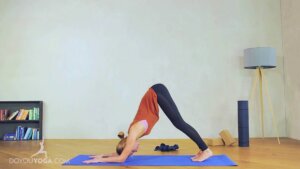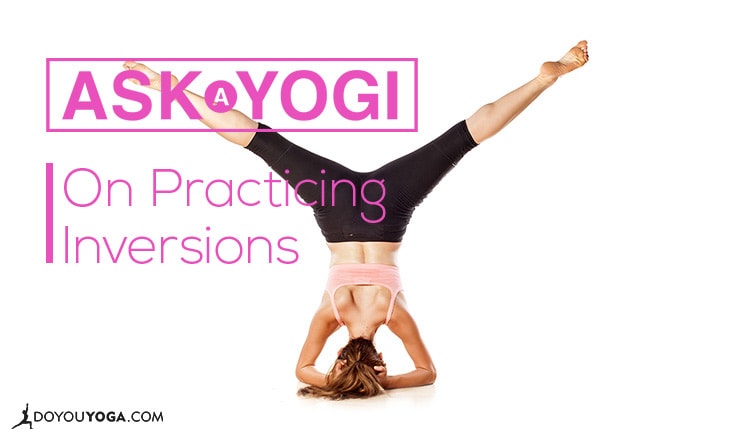Such a common question in the world of yoga is this very one: Do I need to lose weight to practice inversions? And while this question has legitimacy, my answer is always the same: a resounding no.
There is no specific size or weight that a person needs to be in order to achieve inversions with safety and stability. However, in order to achieve (most) inversions with safety and stability, one needs to be able to support their own body weight — regardless of what that body weight may be.
Here is some basic information about inversions and how to work toward achieving both simple and more complex inversions, regardless of how much you weigh:
What Is An Inversion?
An inversion is any physical asana in which the head is below the heart. It is as simple as that. Some can be more challenging and some can be more passive and restorative.
There is no one inversion that gives you more inverting benefits than another. An inversion is an inversion. So, whether you are practicing the super challenging Handstand or a simple Legs Up The Wall, you are receiving the same benefits inherent in any inverted posture.
Benefits Of Inversions
Inverted poses reverse the blood flow within the body to improve circulation. They also help to keep the lymphatic system healthy and circulating. They can both relax and energize you and some inversions also help to improve balance, increase core strength, and build confidence.
On a more esoteric level, inversions literally turn the body upside down, causing you to flip your perspective and see things from a different angle.
Starting Inversions
Inversions come in many different varieties. There are some more “basic” inversions that absolutely anyone can practice. Strong, weak, heavier, skinnier…it doesn’t matter what your limits or capabilities are, any person (without serious injuries) can practice the following inversions:
Viparita Karani (Legs Up The Wall Pose) – literally exactly as it sounds with the legs extending up a wall and the torso flat against the floor. Ideally, your sitbones are as close to the wall as possible.
Uttanasana (Standing Forward Fold) – again, exactly as it sounds. Your feet can either be touching or hip-distance apart. Your knees can either be bent or straight. And you simply fold forward from the hips allowing your torso to relax toward the floor.
Sasangasana (Rabbit Pose) – start kneeling with your knees hip-distance apart. Lengthen your spine as you inhale and, as you exhale, begin to round into your back body, rolling through one vertebra at a time until you reach your most comfortable expression of your rounded spine reaching your head toward the floor.
If it’s accessible to you, you can very gently and lightly relax the crown of your head to the mat (as close toward your knees as possible to maintain the curvature you created in your spine) without applying any pressure to your head or neck.
Inversions That Require More Strength and Control
While the previous inversions can be practiced by anyone, there are other inversions that require more strength and control to perform. Regardless, these postures can be practiced by yogis of all shapes and sizes, providing that they have the proper strength. Some other inversions that require more strength are:
- Adho Mukha Svanasana (Down Dog)
- Ardha Pincha Mayurasana (Dolphin Pose)
- Salamba Sarvangasana (Shoulderstand)
- Salamba Sirsasana (Headstand)
- Pincha Mayurasana (Feathered Peacock Pose/Forearm Stand)
- Adho Mukha Vrksasana (Handstand)
All of these postures require some serious strength and stability, notably within the arms, shoulders and core. In order to prepare for these postures, you can work to build strength in these areas by practicing the following poses.
How To Prepare For Other Inversions
Again, these poses are accessible for practitioners of any size; however, even though these postures are preparatory poses for tougher inversions, they are in no way easy. Take it slow, take modifications, and keep practicing.
Plank Pose

You can stay here maintaining an elongated spine or, if it feels accessible to you, you can tuck your toes underneath and lift your knees up off the floor walking your feet toward the back of your mat until you create a straight line from the top of your head through the tips of your toes.
Kick back through your heels and squeeze your legs into the midline of your body. Hug your bellybutton in toward your spine and continue to press the floor away from you. Hold for as long as you can maintain the proper form.
Forearm Plank

In either option, press down firmly into your forearms so as not to collapse your chest toward the floor.
Dolphin Push-ups

Inhale to lower your hips back to a straight forearm plank and, exhale, to again lift your hips as high as possible. Continue this movement pattern for as long as you can maintain the proper form in your body.
L-shape Handstands (Against a Wall)
Start in a Downward Facing Dog position with your heels touching a wall behind you. Press down firmly into your hands and slowly begin to walk your feet up the wall behind you until you create a perfect 90° angle in your whole body.
Press your feet back against the wall and press the floor away with your hands. Hug your core in firmly and hold for as long as it feels comfortable for you before walking back down the wall. This position is incredibly difficult, but it also is an inversion…so congratulate yourself! You’ve already started your inversion practice!
Yoga is a practice accessible to people of all shapes and sizes as well as all walks of life. There is no proper or ideal size or weight to be a yogi. If the body is ready, then any practitioner, without discrimination, can achieve any pose.
Always remember that yoga is about an internal journey rather than an external one. Your weight is unrelated to your practice. However, your relationship with your body is highly related to your practice.
So, try not to become frustrated or irritated because of limitations that your body may or may not have. Enjoy the process. Enjoy the journey. And fall in love with yourself during the process, whether you can do a Handstand or not.



